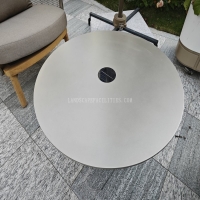Welcome to the website for landscape facilities products and knowledge.
How does the table’s construction minimize noise from items being placed or moved on its surface?
The persistent clatter of objects meeting table surfaces has long been an accepted nuisance in homes and offices worldwide. However, advanced table construction has evolved to address this acoustic challenge through multiple sophisticated approaches that work in harmony to absorb, dampen, and dissipate sound energy before it can reach our ears.
At the foundation of noise reduction lies strategic material selection. High-density rubber composites, cork underlayers, and specialized acoustic foams are integrated beneath the visible surface. These materials function as acoustic buffers, converting the kinetic energy of impact into minimal thermal energy through internal friction. Unlike solid wood or glass that efficiently transmits vibrations, these viscoelastic materials possess both viscous and elastic properties that effectively "swallow" sound waves.
The core construction methodology involves creating what acoustic engineers call a constrained layer damping system. This sophisticated sandwich structure bonds a stiff surface layer (typically wood, glass, or stone) to a flexible damping layer using a specialized viscoelastic adhesive. When an object strikes the surface, the constraining layer bends slightly, shearing the adhesive layer which then converts the vibrational energy into negligible heat. The effectiveness of this system depends on precisely calculating the thickness ratio between layers and selecting adhesives with the optimal loss factor for the expected frequency range.
Beyond surface construction, innovative leg and frame designs contribute significantly to noise reduction. Traditional rigid connections between tabletop and legs act as efficient sound transmission paths. Modern solutions incorporate isolation mounts made of thermoplastic elastomers that create an acoustic break between surfaces. Some advanced designs feature mass-loaded vinyl barriers within hollow legs to block low-frequency transmission, while others use geometric optimization to shift structural resonant frequencies beyond the range most sensitive to human hearing.
Edge design and joinery techniques further enhance acoustic performance. Rounded or bevelled edges minimize the sharp impact sounds created when objects slide across surfaces. Interlocking joints secured with acoustic sealants prevent the subtle rattling that plagues traditional furniture. Some manufacturers even incorporate micro-perforated surfaces in inconspicuous areas that act as Helmholtz resonators, specifically tuned to absorb mid-frequency impacts like typing or writing sounds.
The finishing layer represents the final acoustic frontier. Micro-textured surfaces created through specialized brushing techniques or embedded with microscopic silica beads disrupt the formation of standing waves. Oil and wax finishes have been reformulated with sound-dampening additives that fill wood pores more completely than traditional formulations. For glass surfaces, transparent damping films containing nanoparticles scatter sound waves through controlled impedance mismatches.
Laboratory testing reveals that these integrated approaches can reduce surface-generated noise by up to 15 decibels compared to conventional tables - the difference between a disruptive clatter and barely perceptible thud. This represents not merely incremental improvement but a fundamental reimagining of how surfaces interact with our auditory environment.
The implications extend beyond mere comfort. In educational settings, noise-reduced tables improve concentration; in healthcare environments, they reduce patient stress; in open-plan offices, they lower ambient noise pollution. As acoustic engineering continues to intersect with furniture design, we're witnessing the emergence of truly silent surfaces that transform our relationship with everyday objects, creating spaces where focus can flourish undisturbed by the acoustic byproducts of ordinary activity.
Related search:

Recommendation
Outdoor stainless steel table with solar-powered ambient lighting feature - excellent design.